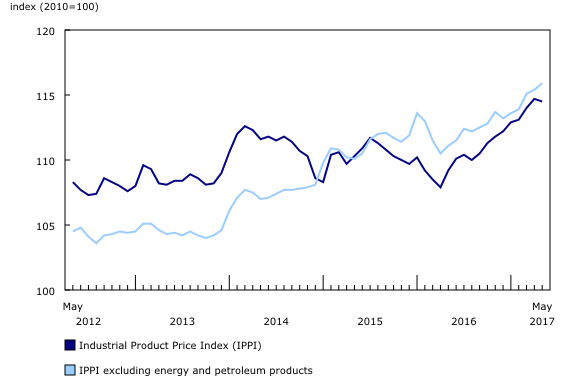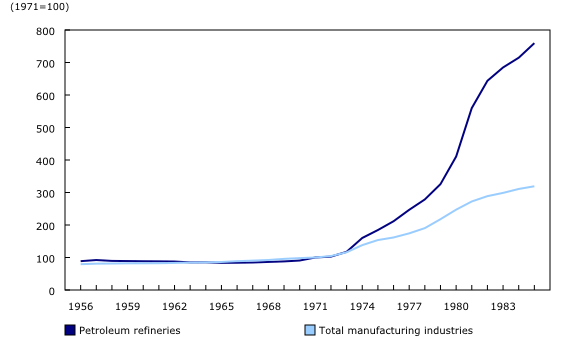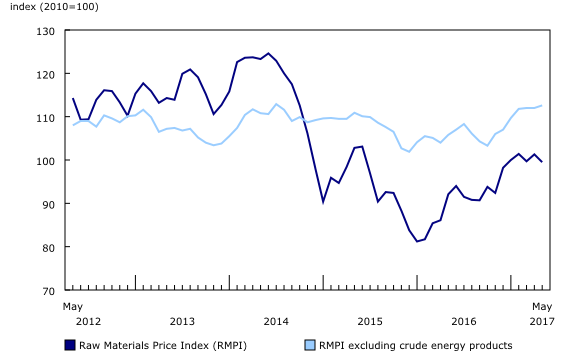Industrial product and raw materials price indexes, May 2017
Archived Content
Information identified as archived is provided for reference, research or recordkeeping purposes. It is not subject to the Government of Canada Web Standards and has not been altered or updated since it was archived. Please "contact us" to request a format other than those available.
Released: 2017-06-30
The Industrial Product Price Index (IPPI) declined 0.2% in May, mainly due to lower prices for energy and petroleum products. The Raw Materials Price Index (RMPI) fell 1.8%, primarily due to lower prices for crude energy products.
Industrial Product Price Index, monthly change
The IPPI declined 0.2% in May, after rising 0.6% in April. This was the first decline in the IPPI since August 2016. Of the 21 major commodity groups, 3 were down, 17 were up and 1 was unchanged.
The decline in the IPPI was mainly due to lower prices for energy and petroleum products (-3.5%). Motor gasoline (-3.3%), light fuel oils (-6.9%) and diesel fuel (-5.6%) were the main contributors to the decline in this product group. The IPPI excluding energy and petroleum products rose 0.4%.
To a lesser extent, primary non-ferrous metal products (-0.7%) also contributed to the decrease in the IPPI. The decline in this product group was largely attributable to lower prices for unwrought precious metals and precious metal alloys (-2.5%), particularly unwrought silver and silver alloys (-5.9%).
Higher prices for meat, fish, and dairy products (+1.7%) moderated the decline in the IPPI. This increase was mainly attributable to higher prices for fresh and frozen beef and veal (+4.9%). Higher prices for fresh and frozen pork (+1.7%) and processed meat products, other meats and animal by-products (+1.1%) also contributed to the increase in this product group.
Pulp and paper products (+1.9%) also moderated the decline in the IPPI. The increase in this product group was primarily due to higher prices for wood pulp (+4.7%).
Prices for motorized and recreational vehicles (+0.3%) also increased in May. The growth in this product group was mainly attributable to higher prices for motor vehicle engines and motor vehicle parts (+0.7%) and aircraft (+1.2%). Higher prices for motorized and recreational vehicles were closely linked to the depreciation of the Canadian dollar relative to the US dollar.
Some IPPI prices are reported in US dollars and converted to Canadian dollars using the average monthly exchange rate. Consequently, any change in the value of the Canadian dollar relative to the US dollar will affect the level of the index. From April to May, the Canadian dollar depreciated 1.2% relative to the US dollar. If the exchange rate had remained constant, the IPPI would have decreased 0.5% instead of 0.2%.
Industrial Product Price Index, 12-month change
The IPPI rose 4.9% over the 12-month period ending in May, after increasing 6.3% in April.
The year-over-year increase in the IPPI was largely attributable to higher prices for energy and petroleum products (+8.9%). Motor gasoline (+5.5%), light fuel oil (+12.8%), diesel fuel (+9.1%) and heavy fuel oils (+23.4%) were the primary contributors to the rise in this commodity group. Year over year, the IPPI excluding energy and petroleum products was up 4.3%.
Compared with the same month a year earlier, primary non-ferrous metal products (+13.3%) also contributed significantly to the increase in the IPPI in May. Higher prices for other unwrought non-ferrous metals and non-ferrous metal alloys (+39.6%) led the gain in this commodity group. Unwrought aluminum and aluminum alloys (+21.5%) and unwrought copper and copper alloys (+24.9%) were also up compared with May 2016.
Year over year, chemicals and chemical products rose 7.4%, primarily due to higher prices for petrochemicals (+27.7%), particularly liquefied refinery gases, and acyclic hydrocarbons not elsewhere classified (+36.3%), and aromatic hydrocarbon gases (+23.0%).
Motorized and recreational vehicles (+3.2%) also rose compared with May 2016. The increase in this commodity group was mainly attributable to higher prices for passenger cars and light trucks (+2.7%), motor vehicle engines and motor vehicle parts (+3.4%) and aircraft (+5.9%).

In celebration of the country's 150th birthday, Statistics Canada is presenting snapshots from our rich statistical history.
After the Second World War, the need to create a set of national accounts to track the economy led to the creation of the Industrial Selling Price Index (ISPI), which was replaced by the Industrial Product Price Index in the 1980s. The ISPI provided a measure of price change for the outputs of Canadian manufacturing industries.
According to the ISPI, prices received by Canadian manufacturers remained relatively stable during a period of sustained economic growth from the 1950s to the early 1970s. This trend changed in the 1970s with the end of the Bretton Woods monetary system, and a period of high inflation and geopolitical instability.
In 1973, as war broke out in the Middle East and members of the Organization of the Petroleum Exporting Countries (OPEC) imposed an oil embargo, buyers bid up oil prices as they tried to build inventories in fear of further oil supply disruptions. In 1979, the Iranian Revolution created a second oil shock which disrupted oil exports. From November 1973 to December 1985, the price of oil increased at a much higher rate than other products in the ISPI. While the total prices received by Canadian manufacturers increased by 166% during that period, oil prices increased by 502%.
Raw Materials Price Index, monthly change
The RMPI was down 1.8% in May, following a 1.6% increase in April. This was the largest decline in the RMPI since July 2016. Of the six major commodity groups, three were down and three were up.
The decrease in the RMPI was mainly due to lower prices for crude energy products (-5.0%), particularly conventional crude oil (-5.0%). This was the largest decline in conventional crude oil since November 2016. The RMPI excluding crude energy products rose 0.5%.
Lower prices for metal ores, concentrates and scrap (-1.8%) also contributed to the decline in the RMPI.
The decrease in the RMPI was partially moderated by higher prices for animals and animal products (+3.1%). The increase in this commodity group was mainly due to higher prices for hogs (+14.7%) and, to a lesser extent, cattle and calves (+1.0%).
Prices for crop products also rose in May (+1.0%). The increase in this commodity group was mainly due to higher prices for canola (including rapeseed) (+4.2%) and wheat (+2.4%).
Raw Materials Price Index, 12-month change
The RMPI rose 8.0% in the 12-month period ending in May, following a 17.7% increase in April.
Compared with May 2016, the increase in the RMPI was largely due to higher prices for crude energy products (+10.3%), primarily conventional crude oil (+10.5%). The RMPI excluding crude energy products rose 6.4%.
Year over year, prices for metal ores, concentrates and scrap (+14.2%) also rose, following a 17.8% gain in April.
To a lesser extent, the animals and animal products group (+3.7%) also contributed to the year-over-year gain in the RMPI. The increase in this product group was mainly attributable to higher prices for cattle and calves (+6.6%), fish, shellfish and other fishery products (+18.0%) and unprocessed fluid milk (+2.8%). Lower prices for hogs (-2.3%) moderated the increase in this commodity group.
Note to readers
Starting with the collection of February 2017 data, the Industrial Product Price Index (IPPI) and Raw Materials Price Index (RMPI) program changed its data collection mode from a paper questionnaire to an electronic questionnaire. The redesigned questionnaire collects additional information on product classification or NAPCS (North American Product Classification System), geography, product characteristics, selling or purchase price, reasons for price change as well as revenue and expenditure data.
The IPPI and RMPI are available at the Canada level only. Selected commodity groups within the IPPI are also available by region.
With each release, data for the previous six months may have been revised. The indexes are not seasonally adjusted.
The Industrial Product Price Index reflects the prices that producers in Canada receive as the goods leave the plant gate. It does not reflect what the consumer pays. Unlike the Consumer Price Index, the IPPI excludes indirect taxes and all the costs that occur between the time a good leaves the plant and the time the final user takes possession of it, including transportation, wholesale and retail costs.
Canadian producers export many goods. They often indicate their prices in foreign currencies, especially in US dollars, which are then converted into Canadian dollars. In particular, this is the case for motor vehicles, pulp, paper and wood products. Therefore, a rise or fall in the value of the Canadian dollar against its US counterpart affects the IPPI. However, the conversion into Canadian dollars only reflects how respondents provide their prices. This is not a measure that takes the full effect of exchange rates into account.
The conversion of prices received in US dollars is based on the average monthly exchange rate (noon spot rate) established by the Bank of Canada and available in CANSIM table 176-0064 (series v37426). Monthly and annual variations in the exchange rate, as described in the release, are calculated according to the indirect quotation of the exchange rate (for example, CAN$1 = US$X).
The Raw Materials Price Index reflects the prices paid by Canadian manufacturers for key raw materials. Many of those prices are set on the world market. However, as few prices are denominated in foreign currencies, their conversion into Canadian dollars has only a minor effect on the calculation of the RMPI.
Infographic: Producer Price Indexes at a Glance
The infographic "Producer Price Indexes at a Glance," which is part of Statistics Canada — Infographics (11-627-M), demonstrates how producer price indexes for goods and services are calculated and why they are important for the Canadian economy.
Real-time CANSIM tables
Real-time CANSIM table 329-8074 will be updated on July 10. For more information, consult the document Real-time CANSIM tables.
Next release
The industrial product and raw materials price indexes for June will be released on July 31.
Contact information
For more information, or to enquire about the concepts, methods or data quality of this release, contact us (toll-free 1-800-263-1136; 514-283-8300; STATCAN.infostats-infostats.STATCAN@canada.ca) or Media Relations (613-951-4636; STATCAN.mediahotline-ligneinfomedias.STATCAN@canada.ca).
- Date modified:






